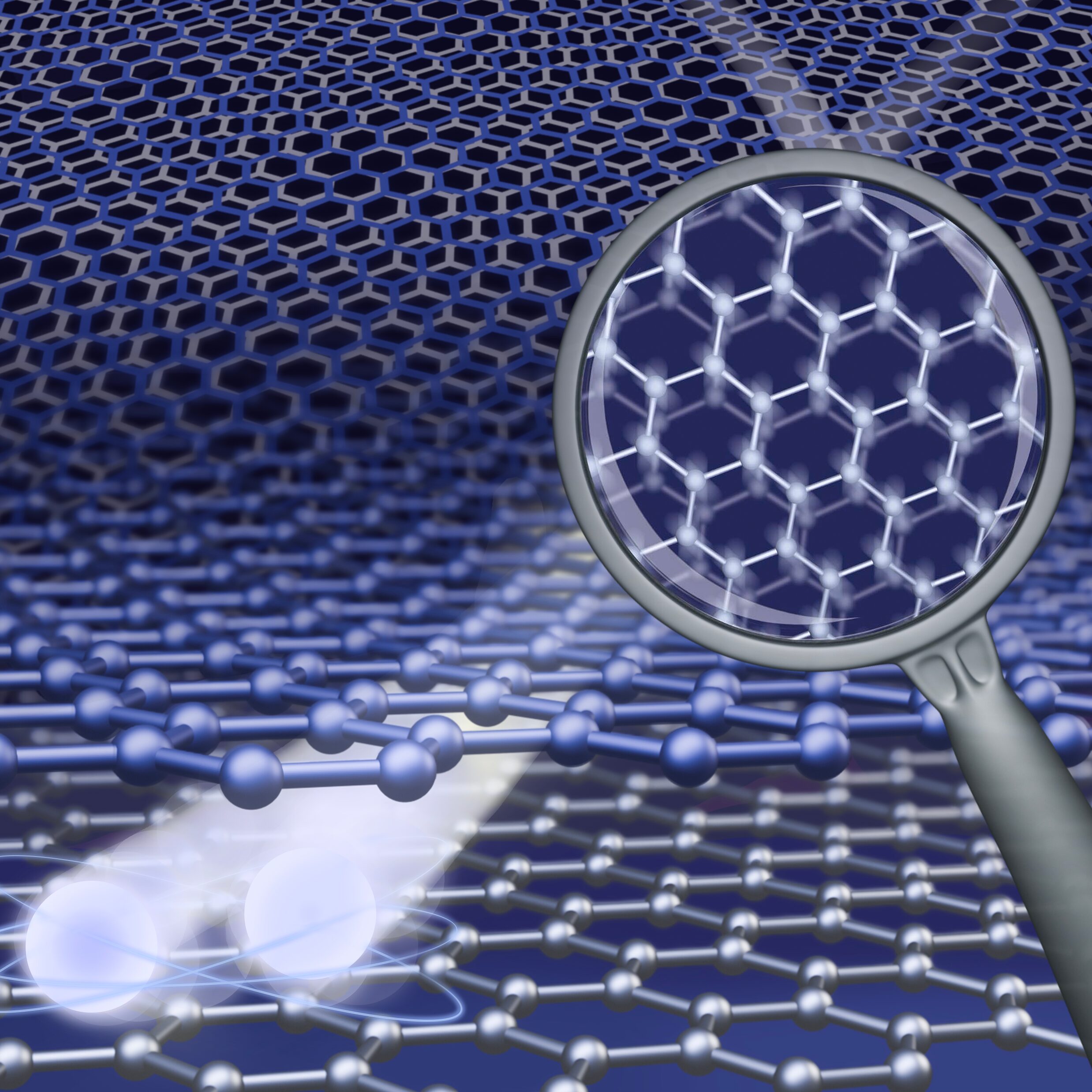Quantum Materials
Quantum materials exhibit collective electron behaviors that challenge and extend beyond traditional reductionist models foundational to semiconductor technology. Such behaviors arise from strong correlations or topological properties and create entanglement across defined spatial ranges. Our research uses quantum many-body simulations to explore quantum materials, with a primary focus on several interconnected areas of interest.
Roles and Fingerprints of Quantum Phonons

In materials, the two principal interactions are the electron-phonon and the electron-electron Coulomb interaction. While even each of them separately can lead to intricate collective phenomena, many interesting phenomena emerge when these interactions are both present and of comparable strength. For example, the combined influence of both interactions is widely considered fundamental to unconventional superconductivity, organic semiconductors, and twistronics. Understanding how quantum phonons interact with strongly correlated electrons is one of the key challenges in quantum materials research. Theoretical exploration of systems with both interactions, however, is often limited by the unbounded nature of the phonon Hilbert space and the complex many-body correlations involved.
Our group investigates strong coupling regimes where phonons contribute to the dynamics in non-perturbative ways. We apply a range of quantum many-body methods — exact diagonalization, quantum Monte Carlo, and density-matrix renormalization group — to model these systems. Beyond standard approaches, we are advancing hybrid variational-numerical methods that use non-Gaussian transformations to unitarily disentangle the electron and phonon subsystems in a dressed-state framework. This approach allows us to simulate strongly dressed states and fluctuating orders that lack mean-field analogs. In addition, we are interested in spectroscopic techniques that quantify the influence of quantum phonons and phonon-mediated interactions.
Relevant papers:
- Chen et al. “Strong Electron-Phonon Coupling in Magic-Angle Twisted Bilayer Graphene“, Nature 636, 342 (2024)
- Liu et al. “Charge Density Wave State in Extremely Overdoped Cuprates Driven by Phonons“, Phys. Rev. B 110, 115133 (2024)
- Chen et al. “Anomalous Excitonic Phase Diagram in Band-Gap-Tuned Ta2Ni(Se,S)5“, Nat. Commun. 14, 7512 (2023)
- Chen et al. “Role of Electron-Phonon Coupling in Excitonic Insulator Candidate Ta2NiSe5“, Phys. Rev. Research 5, 043089 (2023)
- Denner et al. “A Hybrid Quantum-Classical Method for Electron-Phonon Systems“, Commun. Phys. 6, 233 (2023)
- Wang et al. “Phonon-Mediated Long-Range Attractive Interaction in One-Dimensional Cuprates“, Phys. Rev. Lett. 127, 197003 (2021)
- Wang et al. “Fluctuating Nature of Light-Enhanced d-Wave Superconductivity: A Time-Dependent Variational Non-Gaussian Exact Diagonalization Study“, Phys. Rev. X 11, 041028 (2021)
- Wang et al. “Zero-Temperature Phases of the 2D Hubbard-Holstein Model: A Non-Gaussian Exact Diagonalization Study“, Phys. Rev. Research 2, 043258 (2020)
- Chen et al. “Emergence of Interfacial Polarons from Electron-Phonon Coupling in Graphene/h-BN van der Waals Heterostructures“, Nano Lett. 18, 1082-1087 (2018)
- Wang et al. “Tailoring the Nature and Strength of Electron–Phonon Interactions in the SrTiO3 (001) 2D Electron Liquid“, Nat. Mater. 15, 835 (2016)
Entanglement and Fluctuating Order

Characterizing and controlling entanglement are central to quantum technology advancements, yet they pose distinct challenges in materials. Unlike quantum optics or quantum simulators, materials do not allow for precise manipulation of single electrons or twin-state interference experiments. Instead, we focus on entanglement witness approaches through spectroscopies accessible in solid-state environments. Fluctuations of spectroscopic observables provide a lower bound on many-body entanglement. Our work in entanglement witnesses spans both distinguishable spin modes and indistinguishable fermions and bosons, employing diverse spectral techniques.
We also explore fluctuating “orders” that arise without symmetry breaking. In strongly correlated materials, interactions can induce observable properties, such as single-particle gaps, that mimic the signatures of broken-symmetry phases while maintaining symmetry. This phenomenon is especially pronounced in low-dimensional or nanoscale materials. We utilize quantum many-body simulations and machine-learning methods to differentiate these fluctuating states from true broken-symmetry phases. Our interests include fluctuating superconductivity, fluctuating spin states, and fluctuating structural transitions.
Relevant papers:
- Shen et al. “Witnessing Spin–Orbital Entanglement using Resonant Inelastic X-Ray Scattering“, arXiv:2512.06718
- Liu et al. “Entanglement Witness for Indistinguishable Electrons using Solid-State Spectroscopy“, Phys. Rev. X 15, 011056 (2025)
- Chen et al. “Explainable Machine Learning Identification of Superconductivity from Single-Particle Spectral Functions“, Newton 1, 100066 (2025)
- Chen et al. “Role of Electron-Phonon Coupling in Excitonic Insulator Candidate Ta2NiSe5“, Phys. Rev. Research 5, 043089 (2023)
- Hales et al. “Witnessing Light-Driven Entanglement using Time-Resolved Resonant Inelastic X-Ray Scattering“, Nat. Commun. 14, 3512 (2023)
- Peng et al. “Electronic Nature of the Pseudogap in Electron-Doped Sr2IrO4“, npj Quantum Mater. 7, 58 (2022)
- Wang et al. “Fluctuating Nature of Light-Enhanced d-Wave Superconductivity: A Time-Dependent Variational Non-Gaussian Exact Diagonalization Study“, Phys. Rev. X 11, 041028 (2021)
Unconventional Superconductivity

Unconventional superconductivity describes pairing phenomena that remain elusive within the BCS theory framework. A prominent example is high-temperature superconductivity in cuprates, where strong electronic correlations are believed to play a key role in the pairing mechanism. Beyond cuprates, unconventional pairing has been observed in a variety of systems, including specific transition-metal compounds, heavy-fermion systems, and recently explored moiré materials. Our research leverages quantum many-body techniques to analyze superconductivity and related phases in strongly correlated models relevant to these materials, aiming to unravel the complexities of unconventional pairing.
While our work builds on Hubbard-like models, we delve into additional factors that might work in tandem with electronic correlations to stabilize Cooper pairs. For instance, phonon-mediated interactions may enhance the d-wave pairing driven by strong correlations, helping to establish long-range order. Furthermore, charge-transfer characteristics and multi-orbital effects introduce new dimensions to the pairing mechanism, each contributing in unique ways to stabilizing the superconducting state. Together, these factors provide potential control mechanisms, guiding efforts to design and manipulate superconductors.
Relevant papers:
- Song et al. “Interplay between Hole Superconductivity and Quantum Critical Antiferromagnetic Fluctuations in Electron-Doped Cuprates“, Nat. Commun. 16, 2764 (2025)
- Chen et al. “Strong Electron-Phonon Coupling in Magic-Angle Twisted Bilayer Graphene“, Nature 636, 342 (2024)
- Shen et al. “Signatures of the Attractive Interaction in Spin Spectra of One-Dimensional Cuprate Chains“, Phys. Rev. Research 6, L032068 (2024)
- Gao et al. “Magnetic Excitations in Strained Infinite-Layer Nickelate PrNiO2“, Nat. Commun. 15, 5576 (2024)
- Ren et al. “Possible Strain-Induced Enhancement of the Superconducting Onset Transition Temperature in Infinite-Layer Nickelates“, Commun. Phys. 6, 341 (2023)
- Chen et al. “Superconducting Phases of the Square-Lattice Extended Hubbard Model“, Phys. Rev. B 108, 064514 (2023)
- Peng et al. “Enhanced Superconductivity by Near-Neighbor Attraction in the Doped Extended Hubbard Model“, Phys. Rev. B 107, L201102 (2023)
- Qu et al. “Spin-Triplet Pairing Induced by Near-Neighbor Attraction in the Extended Hubbard Model for Cuprate Chain“, Commun. Phys. 5, 257 (2022)
- Chen et al. “Anomalously Strong Near-Neighbor Attraction in Doped 1D Cuprate Chains“, Science 373, 1235 (2021)
- Wang et al. “Emergence of Quasiparticle in Doped Mott Insulators“, Commun. Phys. 3, 210 (2020)
- He et al. “Fermi Surface Reconstruction in Electron-Doped Cuprates without Antiferromagnetic Long-Range Order“, Proc. Natl. Acad. Sci. USA 116, 3449 (2019)
Correlated Systems at Low Dimensions

Electronic states confined to low-dimensional systems are often prone to correlation effects and quantum fluctuations, which can be controlled through mechanisms like gating, surface doping, substrates, and moiré superstructures. These tunable systems offer a valuable setting for exploring complex properties in quantum many-body physics. Notably, low-dimensional platforms are particularly well-suited for comparison between theoretical and experimental results, as quantum many-body methods tend to yield high reliability in these settings.
Our research explores the exotic properties of 1D and 2D correlated systems, including fractionalization, entanglement, and fluctuation phenomena. These wavefunction-level properties often manifest as distinctive signatures in dynamical response functions, creating direct experimental parallels. By mapping theoretical models to measurable dynamical features, we aim to bridge the gap between theoretical understanding and empirical validation of complex quantum states.
Relevant papers:
- Zheng et al. “Electronic Ratchet Effect in a Moiré System: Signatures of Excitonic Ferroelectricity“, arXiv:2306.03922 (2023)
- Chen et al. “Strong Electron-Phonon Coupling in Magic-Angle Twisted Bilayer Graphene“, Nature 636, 342 (2024)
- Shen et al. “Signatures of the Attractive Interaction in Spin Spectra of One-Dimensional Cuprate Chains“, Phys. Rev. Research 6, L032068 (2024)
- Wrzosek et al. “The Fate of the Spin Polaron in the 1D Antiferromagnet“, SciPost Phys. 17, 018 (2024)
- Chen et al. “Anomalous Excitonic Phase Diagram in Band-Gap-Tuned Ta2Ni(Se,S)5“, Nat. Commun. 14, 7512 (2023)
- Chen et al. “Role of Electron-Phonon Coupling in Excitonic Insulator Candidate Ta2NiSe5“, Phys. Rev. Research 5, 043089 (2023)
- Baldini et al. “The Spontaneous Symmetry Breaking in Ta2NiSe5 is Structural in Nature“, Proc. Natl. Acad. Sci. USA 120, e2221688120 (2023)
- Qu et al. “Spin-Triplet Pairing Induced by Near-Neighbor Attraction in the Extended Hubbard Model for Cuprate Chain“, Commun. Phys. 5, 257 (2022)
- Chen et al. :Anomalously Strong Near-Neighbor Attraction in Doped 1D Cuprate Chains“, Science 373, 1235 (2021)
- Zhou et al. “Bilayer Wigner Crystals in a Transition Metal Dichalcogenide Heterostructure“, Nature 595, 48 (2021)
- Chen et al. “Observing Photo-Induced Chiral Edge States of Graphene Nanoribbons in Pump-Probe Spectroscopies“, npj Quantum Mater. 5, 84 (2020)
- Parschke et al. “Numerical Investigation of Spin Excitations in a Doped Spin Chain“, Phys. Rev. B 99, 205102 (2019)
